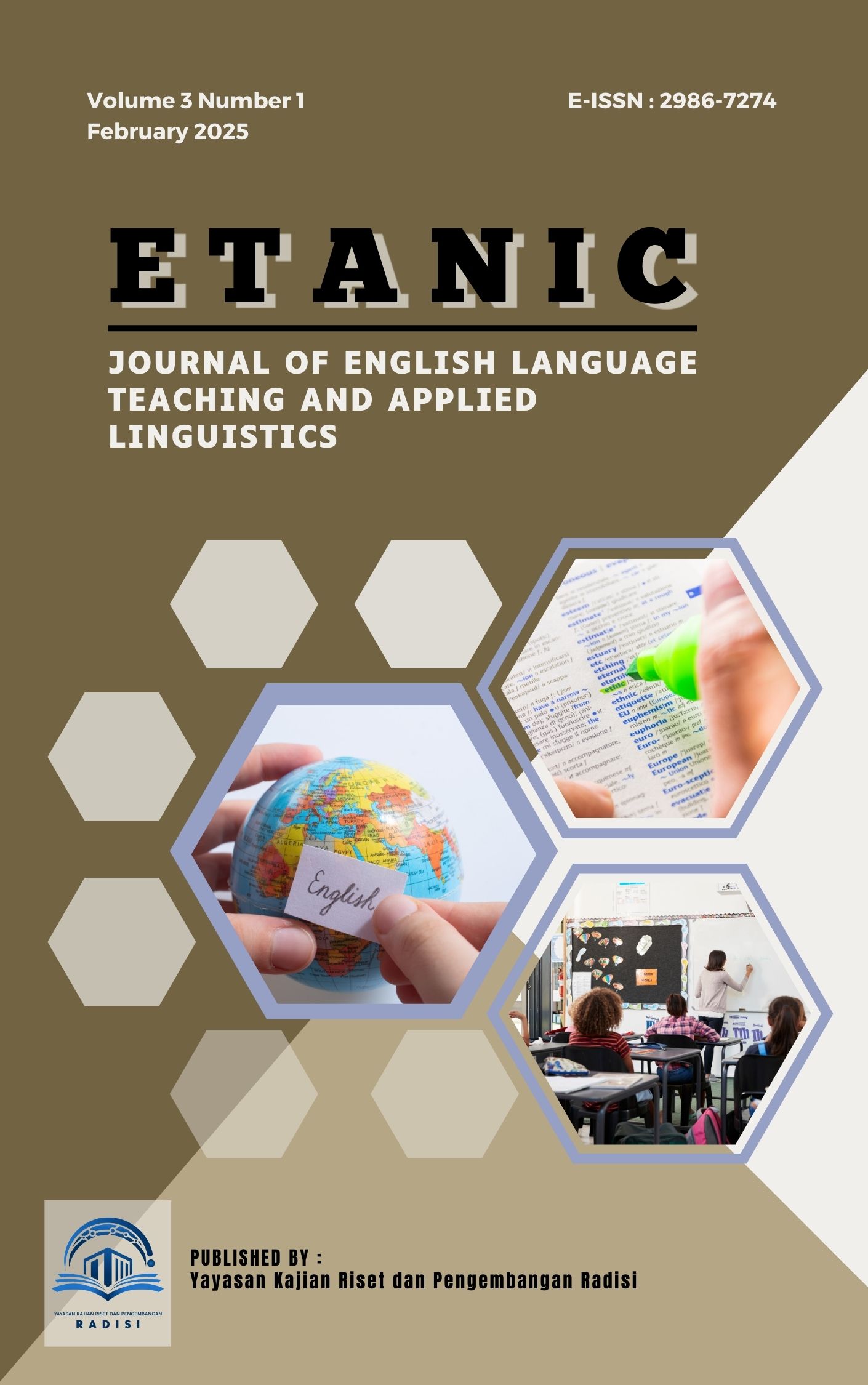Enhancing Students' Reading Comprehension In Descriptive Text Through Directed Reading Thinking Activity (DRTA): A Classroom Action Research At The Tenth Grade Of SMA Negeri 6 Padangsidimpuan
DOI:
https://doi.org/10.55266/journaletanic.v3i1.513Keywords:
Directed Reading Thinking Activity, DRTA, Reading Comprehension, Descriptive Text, EFL LearningAbstract
This research investigates the effectiveness of Directed Reading Thinking Activity (DRTA) in enhancing reading comprehension of descriptive texts among tenth-grade students at SMA Negeri 6 Padangsidimpuan. Using classroom action research with 32 students from Class X-1, the study implemented DRTA through a systematic approach of prediction, verification, and reflection. Initial assessment showed only 15.625% of students achieving scores above the Minimum Competency Criteria (KKM) of 75. Findings demonstrate significant improvement, with average scores increasing from 56.56 in pre-cycle to 71.91 in Cycle I and 83.34 in Cycle II. The percentage of students reaching KKM rose to 90.625% after Cycle II. DRTA effectively transformed reading into an interactive process, addressing key challenges of vocabulary deficiencies and low engagement. The findings highlight the importance of student-centered approaches in EFL reading instruction.
References
Apriliana, A. C. (2022). The Effect Of Drta And Kwl Strategies On Students’ Reading Comprehension Skills In Terms Of Their Reading Interest. PrimaryEdu: Journal of Primary Education, 6(1), 14–29.
Arikunto, S. (2014). Prosedur penelitian : suatu pendekatan praktek. In Rineka Cipta (Ed Revisi). Rineka Cipta.
As’ad, M., & Garwan, H. N. (2022). Teaching Reading Comprehension by Using Directed Reading Activity (DRA) Method to the First Year Nursing students of Universitas Muhammadiyah Gombong. Prosiding University Research Colloquium, 268–278.
Awwalin, U. F. (2020). Pengaruh Strategi Directed Reading Thinking Activity (DRTA) Terhadap Keterampilan Membaca Pada Mata Pelajaran Bahasa Indonesia Kelas V SDI Al-Hidayah Samir Ngunut Tulungagung. IAIN Tulungagung.
But, J., Brown, P., & Smyth, D. (2017). Reading effectively across the disciplines (READ): A strategy to improve student success.
Capin, P., Cho, E., Miciak, J., Roberts, G., & Vaughn, S. (2021). Examining the reading and cognitive profiles of students with significant reading comprehension difficulties. Learning Disability Quarterly, 44(3), 183–196.
Cholsakorn, P. (2020). The effects of differentiated reading instruction on reading comprehension and self-efficacy of undergraduate students.
De-la-Peña, C., & Luque-Rojas, M. J. (2021). Levels of reading comprehension in higher education: systematic review and meta-analysis. Frontiers in Psychology, 12, 712901.
Francois, C., & Hood, M. (2021). Rethinking the role of reading assessments for real learning. Journal for Multicultural Education, 15(3), 299–312.
Harahap, N. H., Sibuea, E. R., & Harahap, R. (2023). Enhancing Reading Comprehension Skills of Class VIII Students through Short Story Implementation: A Case Study at Karya Sejahtera Padangsidimpuan Madrasah Tsanawiyah Education Foundation. ETANIC Journal Of English Language Teaching And Applied Linguistics, 1(2 SE-Artikel). https://doi.org/10.55266/journaletanic.v1i2.373
Hidayat, R. A. U., Gustine, G. G., & Setyarini, S. (2020). Critical Literacy Strategy and Challenges: Voice from a High School EFL Teacher. Jurnal Penelitian Pendidikan, 20(3), 315–324. https://doi.org/10.17509/jpp.v20i3.25399
Hikmah, N., Olii, S. T., & Tuerah, I. J. (2021). The Readability Level of Reading Texts in The English Textbook Entitled When English Rings a Bell For The Seventh Grade Junior High School. KOMPETENSI, 1(03), 368–376.
Huang, Y.-M., Silitonga, L. M., & Wu, T.-T. (2022). Applying a business simulation game in a flipped classroom to enhance engagement, learning achievement, and higher-order thinking skills. Computers & Education, 183, 104494.
Kasper, L. (2000). New technologies, new literacies: Focus discipline research and ESL learning communities.
Kemmis, S. (2021). Improving education through action research. In Action research for change and development (pp. 57–75). Routledge.
Maier, U., & Klotz, C. (2022). Personalized feedback in digital learning environments: Classification framework and literature review. Computers and Education: Artificial Intelligence, 3, 100080.
McCarthy, K. S., & McNamara, D. S. (2021). The multidimensional knowledge in text comprehension framework. Educational Psychologist, 56(3), 196–214.
Nugroho, Y. S., Nurkamto, J., & Sulistyowati, H. (2012). IMPROVING STUDENTS’VOCABULARY MASTERY USING FLASHCARDS. English Education, 1(1).
Nurmadina, H. S., & Yuliah, Y. (2021). The Implementation of Directed Reading Thinking Activity (DRTA) to Improve Students’ Reading Comprehension. Seltics Journal: Scope of English Language Teaching Literature and Linguistics, 63–70.
Oli, I. K. (2024). Teachers’ Understanding and Practices of Continuous Assessment System in ELT Class. Kathmandu University School of Education.
Pouw, O. A., & Mulyanti, D. (2023). Kurikulum 2013 dan kurikulum merdeka dalam pembelajaran bahasa Inggris di jenjang SMA. Jurnal Inspirasi Ilmu Manajemen, 1(2), 77–82.
Pratiwi, S., Maharani, & Meidipa, L. F. (2024). Challenges in Understanding Descriptive Texts Among Eighth-Grade Students at MTs Swasta Darul Akhiroh, Bonan Dolok. ETANIC Journal Of English Language Teaching And Applied Linguistics, 2(1 SE-Artikel). https://doi.org/10.55266/journaletanic.v2i1.367
Pulungan, M. hapni, Maharani, & Meidipa, L. F. (2023). An Analysis of Students’ Reading Comprehension Difficulties in English Texts at SMK Swasta Pancadharma Padangsidimpuan. ETANIC Journal Of English Language Teaching And Applied Linguistics, 1(2).
Rahim, F. (2019). Pengajaran membaca di sekolah dasar. PT Bumi aksara.
Rakhshanfadaee, A. (2022). Cognitive components of reading comprehension in readers with English as an additional language: focusing on higher-order cognitive skills.
Ramadhani, Y. R., & Harputra, Y. (2016). A Comparative Study Between Teaching Reading Comprehension of Narrative Text by Using the Herringbone Technique (HT) and the Context Clues Strategy to the Eighth Grade Students. IOSR Journal of Research & Method in Education (IOSR-JRME), 6(2), 1–5.
Romaito, E. R. R., Siregar, R. K., & Ramadhani, Y. R. (2024). The Relationship Between Students’ Reading Interest and Critical Reading Skills Among Eighth-Grade Students at SMP Negeri 5 Padangsidimpuan. ETANIC Journal Of English Language Teaching And Applied Linguistics, 2(2 SE-Artikel), 80–89. https://doi.org/10.55266/journaletanic.v2i2.390
Safitri, M., Marhaban, S., & Erdiana, N. (2022). A review of Directed Reading Thinking Activity (DRTA) strategy in teaching reading comprehension. English Education Journal, 13(2), 288–302.
Sari, R. N., & Juandi, D. (2023). Improving Student’s Critical Thinking Skills in Mathematics Education: A Systematic Literature Review. Jurnal Cendekia: Jurnal Pendidikan Matematika, 7(1), 845–861.
Septiani, N. F. (2024). An Analysis Of Students’ Difficulties In Reading Comprehension Test On Narrative Text Faced By English Department Students.
Wallace, C. (2014). Critical literacy awareness in the EFL classroom. In Critical language awareness (pp. 58–92). Routledge.
Zulkarnain, I., Nusantari, D. O., Septhiani, S., Sciences, N., Barat, T., & Jakarta, S. (2023). The Effect Of Initial Ability On Students ’ Critical. The 2nd International Conference on Mathematics Education and Technology ( ICOMET) 2023, 333, 332–333.
Downloads
Published
How to Cite
Issue
Section
License
Copyright (c) 2025 Mutiara Cindy Tesalonika Hutapea, Yuswin Harputra , Tinur Rahmawati Harahap

This work is licensed under a Creative Commons Attribution-ShareAlike 4.0 International License.





